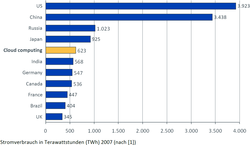Site selection of data centers in terms of sustainability

Due to a constantly growing data volume which is stored in the internet/in the cloud, new data centers are needed. According to a Greenpeace-report, in the year 2007 the Cloud had a higher power requirement than the entire Federal Republic of Germany, which came to 623 TWh [1]. With a growing number of data centers, the power requirement will further increase.
The whole information and communication technology (ICT) experiences increasing emissions of carbon dioxide (CO2). Belonging to the greenhouse gases, carbon dioxide is one of the main drivers of climate change. With the help of Green IT initiatives, the growing CO2 emissions of the ICT are meant to be counteracted. As a part of the ICT, data centers are responsible for ca. one fourth of the ICT carbon dioxide emissions [2].
The IT-equipment of data centers is often responsible for only half of the power consumption [3]. The other half is caused by the infrastructure (air conditioning, uninterruptible power supply, illumination,...). Air-conditioning has a particularly high power requirement and has a 25% share in the power consumption of the data center [3].
The company facebook made headlines with the construction of a news a data center in Lulea (Sweden) near the polar circle. The company chose this location due to low exterior temperatures and clean power, which is primarily extracted out of water power. This example clarified the fact that the location of a data center has a significant impact on its CO2 emissions and its environmental sustainability.
Against this background, an evaluation model for data center locations is created, in the context of which selected, relevant factors such as CO2 emissions caused by applied electricity and ambient temperatures are considered. The importance of these factors is determined by means of literary sources and ca. 15 expert interviews (CIO's, Key Account Managers, experts for infrastructure and operating of global companies from up to 10 different countries). On the basis of sample countries and regions, the operating mode of the evaluation model is demonstrated. This is supposed to allow the identification of cheap data center locations and the evaluation of locations in terms of sustainability.
The initially developped evaluation model has been significantly expanded and finally was awarded the Deutscher Rechenzentrumspreis 2013 in the category "ideas and research". The aim of this call for bids is to support current projects and realizable future visions that make the data center operation more energy-efficient and more sustainable. Further information is available at http://www.future-thinking.de/gewinne. Motivated by this success, the difficulties of the sustainable site selection and the evaluation model will be presented comprehensively in the context of a book in the future.
References
[1] Cook, Gary (2012): How Clean is Your Cloud? Hg. v. Greenpeace International. Amsterdam. Available at: Link (last updated on 16.04.2012, last checked on 20.05.2012).
[2] Global e-Sustainability Initiative; The Boston Consulting Group (Hg.) (2009): Smart 2020 Addendum Deutschland: Die IKT-Industrie als treibende Kraft auf dem Weg zu nachhaltigem Klimaschutz. Available at: Link (last updated on 03.12.2009, last checked on 20.05.2012).
[3] Deutsche Energie-Agentur GmbH (dena) (2009): Leistung steigern, Kosten senken: Energieeffizienz im Rechenzentrum. Available at: Link (last checked on 24.06.2012).





